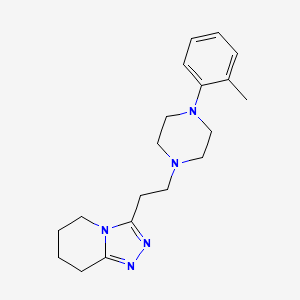



1. 3-(2-(4-(2-methylphenyl)-1-piperazinyl)ethyl)-5,6,7,8,-tetrahydro-1,2,4-triazolo(4,3-a)pyridine Hydrochloride
2. Dapiprazole Hydrochloride
3. Remydrial
4. Rev-eyes
1. 72822-12-9
2. Dapiprazol
3. Dapiprazole [inn]
4. Glamidolo
5. Reversil
6. Remydrial
7. Dapiprazole (inn)
8. 5,6,7,8-tetrahydro-3-(2-(4-(o-tolyl)-1-piperazinyl)ethyl)-s-triazolo(4,3-a)pyridine
9. 5rnz8gjo7k
10. 3-[2-[4-(2-methylphenyl)piperazin-1-yl]ethyl]-5,6,7,8-tetrahydro-[1,2,4]triazolo[4,3-a]pyridine
11. Chebi:51066
12. 72822-12-9 (free Base)
13. Dapiprazol [german]
14. Dapirazolum
15. Dapirazol
16. Dapirazol [inn-spanish]
17. Dapirazolum [inn-latin]
18. 1,2,4-triazolo(4,3-a)pyridine, 5,6,7,8-tetrahydro-3-(2-(4-(2-methylphenyl)-1-piperazinyl)ethyl)-
19. Dapiprazolum
20. 1-(2-methylphenyl)-4-(2-{5h,6h,7h,8h-[1,2,4]triazolo[4,3-a]pyridin-3-yl}ethyl)piperazine
21. Unii-5rnz8gjo7k
22. Dapiprazole [mi]
23. Dapiprazole [vandf]
24. Dapiprazole [who-dd]
25. Schembl152543
26. Gtpl7155
27. Zinc1246
28. Chembl1201216
29. Dtxsid90223140
30. Hy-a0142
31. Akos024463973
32. Db00298
33. 3-(2-(4-(o-tolyl)piperazin-1-yl)ethyl)-5,6,7,8-tetrahydro-[1,2,4]triazolo[4,3-a]pyridine
34. Ncgc00262927-03
35. 3-{2-[4-(2-methylphenyl)piperazin-1-yl]ethyl}-5,6,7,8-tetrahydro[1,2,4]triazolo[4,3-a]pyridine
36. Db-055682
37. Cs-0017462
38. Ft-0603131
39. D07775
40. 822d129
41. L000681
42. Q901963
43. 3-(2-(4-o-tolylpiperazin-1-yl)ethyl)-5,6,7,8-tetrahydro-[1,2,4]triazolo[4,3-a]pyridine
44. 5,6,7,8-tetrahydro-3-(2-(4-o-tolyl-1-piperazinyl)ethyl))-s-triazolo(4,3-a)pyridine
| Molecular Weight | 325.5 g/mol |
|---|---|
| Molecular Formula | C19H27N5 |
| XLogP3 | 2.4 |
| Hydrogen Bond Donor Count | 0 |
| Hydrogen Bond Acceptor Count | 4 |
| Rotatable Bond Count | 4 |
| Exact Mass | 325.22664588 g/mol |
| Monoisotopic Mass | 325.22664588 g/mol |
| Topological Polar Surface Area | 37.2 Ų |
| Heavy Atom Count | 24 |
| Formal Charge | 0 |
| Complexity | 395 |
| Isotope Atom Count | 0 |
| Defined Atom Stereocenter Count | 0 |
| Undefined Atom Stereocenter Count | 0 |
| Defined Bond Stereocenter Count | 0 |
| Undefined Bond Stereocenter Count | 0 |
| Covalently Bonded Unit Count | 1 |
Used in the treatment of iatrogenically induced mydriasis produced by adrenergic (phenylephrine) or parasympatholytic (tropicamide) agents used in certain eye examinations.
FDA Label
Dapiprazole is an alpha-adrenergic blocking agent. It produces miosis by blocking the alpha-adrenergic receptors on the dilator muscle of the iris. Dapiprazole produces no significant action on ciliary muscle contraction and thus, there are no changes in the depth of the anterior chamber of the thickness of the lens. It does not alter the IOP either in normal eyes or in eyes with elevated IOP. The rate of pupillary constriction may be slightly slower in clients with brown irises than in clients with blue or green irises.
Adrenergic alpha-Antagonists
Drugs that bind to but do not activate alpha-adrenergic receptors thereby blocking the actions of endogenous or exogenous adrenergic agonists. Adrenergic alpha-antagonists are used in the treatment of hypertension, vasospasm, peripheral vascular disease, shock, and pheochromocytoma. (See all compounds classified as Adrenergic alpha-Antagonists.)
Antipsychotic Agents
Agents that control agitated psychotic behavior, alleviate acute psychotic states, reduce psychotic symptoms, and exert a quieting effect. They are used in SCHIZOPHRENIA; senile dementia; transient psychosis following surgery; or MYOCARDIAL INFARCTION; etc. These drugs are often referred to as neuroleptics alluding to the tendency to produce neurological side effects, but not all antipsychotics are likely to produce such effects. Many of these drugs may also be effective against nausea, emesis, and pruritus. (See all compounds classified as Antipsychotic Agents.)
S - Sensory organs
S01 - Ophthalmologicals
S01E - Antiglaucoma preparations and miotics
S01EX - Other antiglaucoma preparations
S01EX02 - Dapiprazole
Absorption
Systemic absorption is negligible.
Dapiprazole acts through blocking the alpha1-adrenergic receptors in smooth muscle. It produces miosis through an effect on the dilator muscle of the iris and does not have any significant activity on ciliary muscle contraction and, therefore does not induce a significant change in the anterior chamber depth or the thickness of the lens.